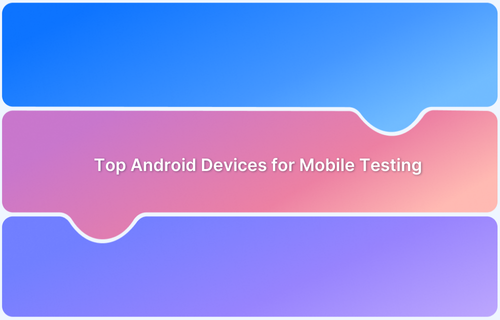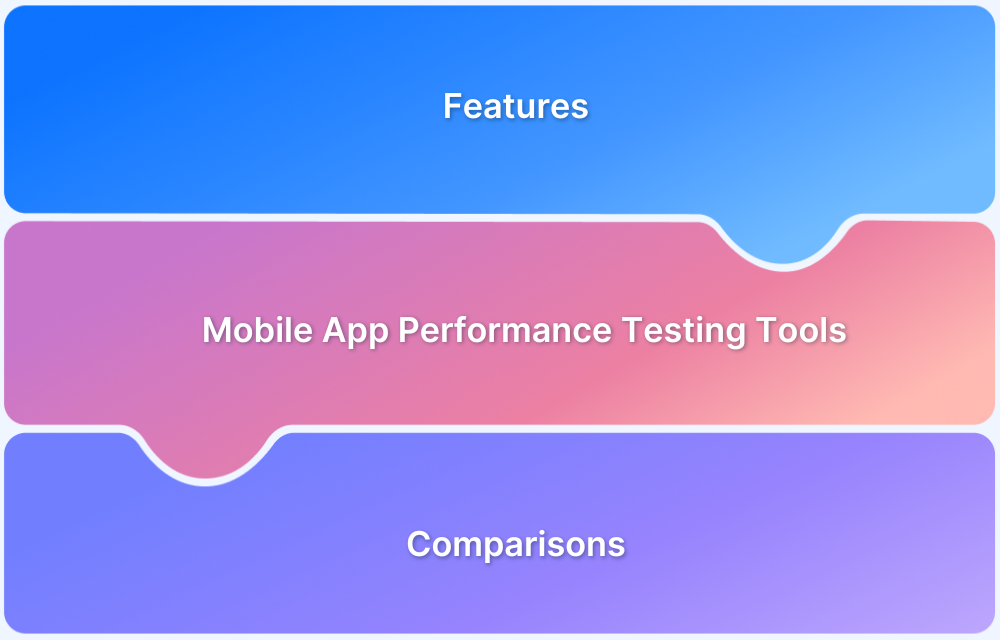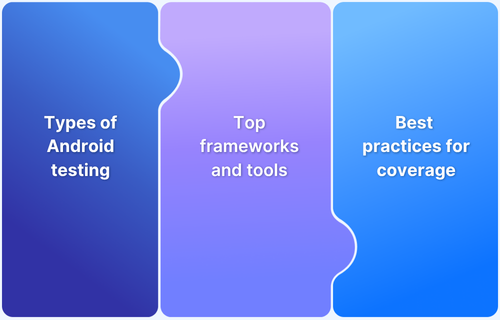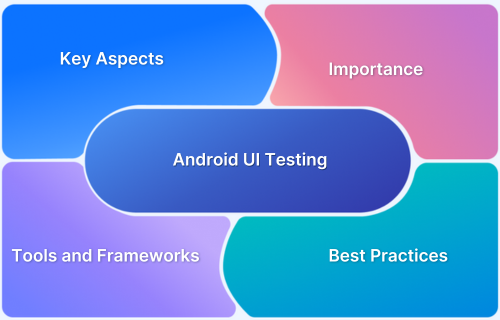Android app performance testing involves assessing how well an app runs, focusing on speed, responsiveness, and stability. Users expect apps to load quickly, run smoothly, and use minimal battery. Even small issues like lag, crashes, or high resource consumption can lead to poor reviews, more uninstalls, and lost revenue.
Overview
Top Android App Performance Testing Tools in 2025
- BrowserStack App Performance
- Android Studio Profiler
- TestFairy
- New Relic Mobile
- Apptim
- Instabug Performance Monitoring
- JMeter
Prioritizing performance testing at every stage of development helps deliver a seamless user experience
What is Android App Performance Testing?
Android App Performance Testing ensures that mobile applications run smoothly without issues like crashes or slowdowns. It checks how well apps respond to user interactions, handle data, and manage resources like memory and CPU usage.
Why do you need Android App Performance Testing Tools?
Android app performance testing tools are essential for identifying and addressing performance issues that can affect the user experience. These tools help pinpoint key challenges that can arise across different devices and conditions.
- Identify Performance Issues: The primary reason for using performance testing tools is to identify issues like slow load times, memory leaks, excessive CPU usage, and lagging interfaces. Early detection of these issues helps in optimizing the app before it reaches users.
- Device and Android OS Fragmentation: The Android ecosystem is vast, with a wide range of devices, screen sizes, chipsets, and operating system versions. Performance testing tools ensure the app performs consistently across these different conditions, catching issues that may only appear on specific devices or OS versions.
- Test on Real World Conditions: Users often interact with apps under less-than-ideal conditions, such as poor network connections, low-end devices, or while multitasking. Performance testing tools simulate these real-world scenarios, allowing developers to ensure the app performs well in diverse environments.
- User Experience and Performance: Performance issues like slow load times, unresponsive screens, or lag can lead to frustrated users and high uninstall rates. These tools help developers pinpoint and resolve these issues, improving user satisfaction and engagement.
- App Store Visibility and Revenue: App stores rank apps based on performance, with optimized apps more likely to be featured and ranked higher. By addressing performance issues, developers can improve app visibility, boost retention, and drive higher revenue.
- Data-Driven Decisions: Performance testing tools provide detailed metrics, such as CPU usage, memory consumption, and frame rates. These insights allow developers to track app performance, make>
Top Android App Performance Testing Tools (2025)
Here’s a detailed list of top Android App Performance Testing Tools:
1. BrowserStack App Performance
BrowserStack App Performance tool provides real-time insights into key metrics like CPU, memory, network, and energy usage during app execution. It allows developers to evaluate their Android apps on real devices, ensuring that performance issues are identified under realistic conditions, such as varying network speeds and device capabilities. The platform helps pinpoint issues such as memory leaks, CPU spikes, and inefficient energy consumption, offering actionable data for optimizing app performance.
With intuitive dashboards and detailed reports, BrowserStack App Performance enables developers to quickly identify bottlenecks and resolve issues that could impact speed, responsiveness, or battery life. By testing on real devices rather than emulators, the tool ensures accurate results, reflecting how the app performs in real-world scenarios and contributing to a more stable and efficient app experience.
Pros:
- Fully integrated into the Android development environment
- Provides detailed, live visualizations of app behaviour
- Helps identify resource spikes and inefficiencies early on
Features:
- Real Device Testing: Run performance tests on real Android and iOS devices, ensuring results that accurately reflect actual user experiences across various hardware configurations.
- Comprehensive Metrics: Monitor essential performance indicators like CPU usage, memory consumption, network performance, and energy consumption to identify potential bottlenecks.
- Network Simulation: Simulate real-world network conditions (example, 3G, 4G, and 5G) to understand how apps perform under different connectivity scenarios.
- Actionable Insights: Gain real-time visibility into app performance with detailed, easy-to-read reports and dashboards, highlighting issues like latency, crashes, and resource usage.
- Cross Browser Testing and Cross Device Testing: Test across a wide range of devices and browsers to ensure consistent app performance on different screen sizes, OS versions, and network conditions.
- Performance Comparison: Compare performance metrics across different devices and operating systems to identify areas of improvement and optimize apps accordingly.
- Energy Usage Monitoring: Track and optimize the energy consumption of your app, ensuring it runs efficiently on mobile devices without draining battery life.
- Automated Performance Tests: Automate the execution of performance tests to save time and effort, allowing teams to focus on identifying and fixing issues.
- Detailed Error Logs: Get access to detailed logs that provide a deep dive into performance failures, making it easier to diagnose and resolve problems quickly. Generate comprehensive audit reports (PDF and raw logs) highlighting issues with severity and actionable guidance
- Seamless Integration: Integrate easily with continuous integration (CI) systems, enabling automated performance testing as part of the app development pipeline.
Verdict
The BrowserStack App Performance tool enables early-stage performance tuning by detecting bottlenecks-like slow load times, memory leaks, and inefficient resource usage-during development. This helps developers optimize performance and user experience well before the app reaches production.
2. Android Studio Profiler
Android Studio Profiler is a native tool bundled with Android Studio, offering live profiling of CPU, memory, network, and energy usage during app execution.
It is a built-in tool that helps developers monitor and optimize app performance by tracking CPU usage, memory allocation, network activity, and battery impact in real-time, enabling efficient debugging and performance tuning on Android devices.
Pros:
- Fully integrated into the Android development environment
- Offers real-time, detailed visualizations of app behavior
- Useful for spotting resource spikes and inefficiencies early
Cons:
- Limited to local development; not ideal for production testing
- Doesn’t support automated performance workflows or large-scale testing
Features
- Real-Time Performance Monitoring: The Android Studio Profiler provides real-time data on app performance, including CPU, memory, and network usage, allowing developers to monitor how their app performs during execution.
- Memory Analysis: The profiler offers tools to track memory usage, detect memory leaks, and visualize heap allocations, helping developers identify memory inefficiencies that could lead to crashes or slow performance.
- CPU Profiling: It enables detailed CPU analysis, allowing developers to track method-level performance, identify bottlenecks, and optimize the app’s processing speed by visualizing CPU usage and execution times.
- Network Activity Tracking: The profiler captures network requests and responses, providing insight into data transfer speeds, latency, and network consumption, which is crucial for apps that rely on real-time data or APIs.
- User-Friendly Interface: With an intuitive, interactive interface, Android Studio Profiler allows developers to easily visualize performance metrics over time, compare different performance states, and quickly isolate areas needing optimization.
Verdict
Android Studio Profiler is highly effective for early-stage performance tuning, providing developers with the tools to pinpoint and resolve performance bottlenecks during the development phase. By offering detailed insights into CPU, memory, and network usage, it helps optimize app performance before reaching production, ensuring a smoother user experience and reducing the risk of issues in the final release.
3. TestFairy
TestFairy is a mobile app testing platform that provides in-depth video recordings, performance metrics, and crash reports from real user sessions, enabling developers to identify bugs, optimize performance, and enhance user experience across Android and iOS apps.
It is a session-based performance monitoring tool that provides in-app performance data, logs, videos, and user behavior heatmaps.
Pros:
- Captures CPU, memory, logs, and UI performance metrics during user sessions.
- Session recording allows visual playback of performance issues
- Supports over-the-air app distribution and feedback collection
Cons:
- More useful for QA and beta testing than continuous automation
- Limited depth in synthetic or large-scale load testing
Features:
- Real-Time Performance Data: Provides detailed data on CPU usage, memory consumption, and network performance during app testing.
- Video Recording of Sessions: Records the user’s interaction with the app, allowing developers to see how the app performs during specific actions.
- Crash Reporting: Automatically generates crash reports with stack traces and device information to simplify debugging.
- Device and OS Support: Supports a wide range of Android devices and OS versions, ensuring testing across diverse environments.
- User Feedback Integration: Testers can leave feedback directly within the app, helping developers understand user experience issues.
Verdict:
TestFairy is an excellent choice for gathering real-time performance data, exploratory testing sessions, and integrating user feedback during early testing phases to optimize app performance.
4. New Relic Mobile
New Relic Mobile is a performance monitoring tool for Android and iOS apps that provides real-time insights into app crashes, network failures, UI response times, and user interactions, helping developers detect issues and optimize app performance and stability.
This is an observability platform that monitors Android app performance in production, focusing on user experience, crashes, and interaction traces.
Pros:
- Tracks detailed crash analytics, response times, and user flow bottlenecks
- Supports distributed tracing and backend dependency analysis
- Provides real-time alerts and historical performance trends
Cons:
- Enterprise-grade tool with a steeper pricing curve
- Best suited for apps already in production
Features:
- Comprehensive App Monitoring: Provides deep insights into app performance, including real-time metrics on response times, memory usage, and crashes.
- User Interaction Analysis: Tracks user interactions and correlates them with performance issues to understand how app performance impacts user experience.
- Crash Analytics: Offers detailed crash reports with device-specific information and stack traces, making it easier to resolve critical issues.
- Network Performance Monitoring: Monitors network requests, latency, and failed requests, essential for apps reliant on real-time data.
- Error Tracking and Alerts: Sends real-time alerts for performance issues, allowing developers to proactively address problems.
Verdict:
New Relic Mobile provides robust performance monitoring with detailed insights into user experience and network performance, making it ideal for teams looking to track app behavior and improve reliability.
5. Apptim
Apptim is a desktop-based mobile performance testing platform that monitors CPU, memory, network, battery usage, render times, crashes, and user interactions on real Android/iOS devices.
Apptim is a mobile performance profiler for Android and iOS that allows local testing of native apps on real devices. It generates detailed reports and comparative analytics without requiring SDK integration
Pros:
- Captures frame rate, memory, CPU, power usage, and app size
- Offers side-by-side comparisons for performance regression testing
- No coding required to set up and run tests
Cons:
- Manual execution; lacks CI/CD automation support
- Limited scalability for large teams or continuous testing
Features:
- App Performance Testing on Real Devices: Allows testing on real devices for accurate performance insights, unlike emulators.
- Speed and Battery Usage Analytics: Tracks app load times and energy consumption to ensure optimal speed and battery efficiency.
- Automated Regression Testing: Automatically runs tests on new app versions to ensure that performance improvements are maintained without introducing new issues.
- Network Condition Simulation: Simulates various network speeds (2G, 3G, 4G) to assess app performance under different connectivity conditions.
- Visual Performance Reports: Provides clear, visual reports highlighting performance bottlenecks and areas for improvement.
Verdict:
Apptim is a practical solution for teams focused on battery efficiency, speed, and network performance, offering real-device testing and useful insights into performance optimization.
6. Instabug Performance Monitoring
Instabug is a lightweight SDK that collects real-time performance metrics by tracking Apdex scores, UI hangs, launch times, screen load delays, network transactions, and custom traces helping teams swiftly detect, prioritize, and resolve performance issues across devices
Pros:
- Easy to integrate and configure
- Tracks app launch, UI responsiveness, and network performance
- Pairs well with in-app feedback and bug reporting features
Cons:
- SDK-based approach may add slight overhead
- Less suitable for automated or large-scale stress testing
Features:
- Real-Time Performance Monitoring: Tracks CPU, memory, and network usage in real-time, providing instant feedback on app performance.
- Crash and ANR Reporting: Offers detailed reports for crashes and application not responding (ANR) errors, helping developers address issues quickly.
- Network Performance Insights: Monitors API requests and network responses, providing insights into latency and error rates.
- Custom Performance Metrics: Developers can define and track custom performance metrics specific to their app’s functionality.
- User Feedback and Bug Reporting: Integrates bug reporting and feedback collection directly within the app, allowing users to report issues effortlessly.
Verdict:
Instabug combines comprehensive performance monitoring with seamless user feedback collection, making it an ideal tool for teams that need detailed crash reports and real-time performance insights.
7. JMeter
Apache JMeter is an open-source load testing tool commonly used for testing the performance of backend services and APIs that support Android apps.
Apache JMeter is used to analyze and measure the performance of web and mobile applications. It simulates multiple users, tests server load, and monitors response times to identify bottlenecks and ensure scalability.
Pros:
- Supports HTTP, REST, JDBC, and more
- Customizable test plans with scripting support
- Ideal for testing backend performance under concurrent load
Cons:
- Not designed for client-side or UI-level performance testing
- Requires technical setup and scripting knowledge
Features:
- Load Testing: Simulates heavy loads to test how the app performs under stress, particularly useful for network and API testing.
- API Performance Testing: Provides detailed performance testing for backend APIs, which is crucial for apps with heavy server dependencies.
- Extensive Plugin Support: Supports numerous plugins that enhance its functionality, including additional performance monitoring features.
- Distributed Testing: Allows for distributed testing to simulate traffic from multiple locations, providing more comprehensive performance evaluations.
- Comprehensive Reporting: Offers detailed reports and analytics to help developers pinpoint performance bottlenecks.
Verdict:
JMeter excels in load and stress testing, particularly for server-side and API performance. It is ideal when used alongside mobile performance tools for a comprehensive app testing strategy.
Key Metrics for Android Performance Testing
Tracking the right android performance metrics is essential for identifying bottlenecks, optimizing resource usage, and ensuring a smooth user experience.
1. App Launch Time
- Measures the time it takes for the app to start from both a cold and warm state.
- Affects first impressions and how quickly users perceive the app to load.
- This metric is critical for both initial installs and everyday use.
2. Frame Rate and Jank
- Monitors how smoothly the UI renders, usually measured in frames per second (FPS).
- “Jank” refers to skipped or dropped frames that cause lag during animations.
- This is crucial for apps with animations, scrollable views, or custom UIs.
3. Memory and CPU Usage
- Shows how efficiently the app uses system resources like memory and CPU.
- Excessive memory or CPU usage can result in overheating, crashes, and increased battery drain.
- Helps detect memory leaks and performance degradation over time.
4. Battery Consumption
- Measures the app’s power usage during active and background states.
- Excessive battery consumption negatively impacts user satisfaction and app ratings.
- Often assessed during extended or idle usage periods.
5. Network Throughput and Latency
- Tracks the speed of upload/download and response times for API calls.
- High latency or failed requests can delay screen loading, block functionality, or degrade performance on slow networks.
- This is particularly important for apps relying on real time data, streaming, or frequent API calls.
6. Crash Rate and Stability Index
- Monitors how often the app crashes and the severity of these crashes.
- The Stability Index (such as, sessions without a crash) provides a broader view of the app’s overall health.
- Lower crash rates directly contribute to higher user retention and better store rankings.
How to Choose the Right Android Performance Testing Tool
Choosing the right Android performance testing tool depends on several key factors related to your app’s needs and your team’s workflow. Here’s why each factor matters:
1. App Type (Native, Hybrid, Web)
The type of app you’re testing determines the kind of performance metrics you need. Native apps often require system-level insights, while hybrid or web-based apps benefit from tools that handle cross platform performance, ensuring consistency across different environments.
2. Team Size and Budget
Smaller teams or solo developers might have limited resources, so free or low-cost tools are ideal.
Larger teams or enterprises often need more advanced capabilities, such as in-depth analysis, integrations with continuous integration systems, and the ability to scale testing efforts, making premium tools a better fit.
3. Real Device Testing vs Emulator
Emulators are useful for development but don’t replicate real world performance challenges, such as varying network conditions or hardware limitations.
Real device testing is crucial for accurate data on how an app will behave in different user environments, providing better insights into user experience and performance under real world conditions.
4. CI/CD and Automation Compatibility
As development teams increasingly adopt CI/CD pipelines, the ability to automate performance testing becomes essential.
Tools that integrate with CI/CD systems allow for automated performance checks with each new build, ensuring that performance regressions are detected early in the development cycle.
5. Depth of Performance Metrics
The level of detail in the metrics you need depends on your app’s complexity. If you’re focusing on smooth UI interactions, you’ll need tools that offer detailed UI performance metrics like frame rates and responsiveness.
For apps with heavy backend interactions, tools that track network performance and API load will be more important. Understanding which metrics are most relevant to your app’s functionality helps you choose the right tool.
Pro Tip:
For the most accurate performance insights, always test your app on real devices using BrowserStack App Performance. Emulators can’t replicate real world conditions like varying network speeds or hardware limitations, so running tests on actual devices ensures you’re capturing the true performance of your app across a range of user environments.
How BrowserStack helps optimize Android App Performance?
BrowserStack App Performance allows automated testing of native and hybrid Android apps on real devices. It tracks performance metrics like CPU usage, memory, and how the app responds to user interactions, helping teams understand how the app behaves under normal and extreme conditions.
Why it matters:
By automating performance checks within your CI/CD pipeline, it helps detect performance issues early, before they affect users. Tracking key metrics over time also helps prevent slowdowns, which is crucial in Agile development or continuous delivery environments.
Use Case:
Best suited for QA teams, developers, and engineers who need to monitor performance and catch issues during rapid development cycles.
- Measure app launch time.
- Track screen transitions and loading speeds.
- Identify rendering bottlenecks or UI jank.
Conclusion
Performance testing has become essential in Android app development, playing a crucial role in ensuring responsive, stable, and high-quality user experiences. With the growing challenges of device fragmentation, varying real world conditions, and rising user expectations, unoptimized apps face risks such as low retention, poor ratings, and lost revenue.
Selecting the appropriate performance testing tool depends on factors like app architecture, team capabilities, and specific testing objectives.
Whether monitoring app performance in production, benchmarking user experience on real devices, or automating tests in CI/CD workflows, there are tools available to suit every testing need.
FAQs
1. Which tool is best for Android App Performance Testing?
It depends on your needs. For native app automation and regression detection, BrowserStack App Performance is a strong choice. Tools like Android Studio Profiler are great for early development and monitoring.
2. How do I test Android app performance across real devices?
Use platforms like BrowserStack, TestFairy, or Apptim that offer access to real Android hardware. Real-device testing provides more accurate metrics than emulators and reveals performance issues users are likely to face.
3. Can I automate Android performance testing?
Yes. tools such as BrowserStack App Performance, JMeter, BlazeMeter, and NeoLoad allow you to automate performance checks as part of your CI/CD pipeline and track metrics across builds.










